Australian rules football in New South Wales
Australian rules football in New South Wales dates back to 1866 when a number of short-lived Sydney clubs adopted the sport. By the early 1870s, Australian football had been supplanted by rugby football in Sydney, but saw renewed local interest near the end of the decade with the arrival of touring clubs from Victoria and South Australia. Organised competition has been continuous in New South Wales since the 1880s, from which time several regions have developed into strongholds of Australian football, including Broken Hill on the South Australian border, and the Riverina and the South Coast, which border Victoria. In other, more populous areas of New South Wales, including Sydney, rugby league and rugby union have maintained a higher profile than Australian football.
| Australian rules football in New South Wales | |
|---|---|
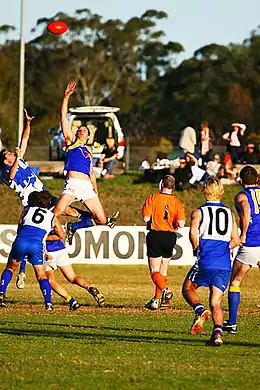 Two ruckmen contest the bounce in a suburban western Sydney AFL game between the East Coast Eagles AFC and Campbelltown Kangaroos AFC | |
| Representative team | New South Wales |
| First played | 17th June, 1865, Sydney[1] |
| Registered players | 69,168 (total)[2] 7,225 (adult) |
Club competitions | |
Audience records | |
| Single match | 72,393 (2003). Sydney Swans Football Club v. Collingwood Football Club. (Telstra Stadium, Sydney) |
In 1982, the then-Victorian Football League (now the national Australian Football League) began expanding interstate by relocating the South Melbourne Football Club to Sydney to become the Sydney Swans. After years of struggle, the Swans found on-field success in the 1990s, boosting club membership and spectator numbers, as well as Australian football's popularity more broadly in the state.[3] A second Sydney-based AFL club, the Greater Western Sydney Giants, was established in 2009. Both clubs compete in the Sydney Derby.
New South Wales holds the record attendance for Australian football outside Victoria, with 72,393 attending a Swans v. Collingwood match at Sydney's Telstra Stadium in 2003. It was also the first state outside of Victoria to host Australian Football International Cup matches, during the 2011 tournament. Participation rates have also increased, with Australian football surpassing rugby union in the late 2010s to become the third most participated football code in the state.[4]
Two leading pioneers of the sport, cousins Tom Wills and H. C. A. Harrison, were born in New South Wales, while hundreds of New South Welshmen have competed in the VFL/AFL, among the most notable being Haydn Bunton Sr. and Jock McHale, who have attained 'Legend' status in the Australian Football Hall of Fame. Other Hall of Famers from New South Wales include Paul Kelly, Lenny Hayes and Shane Crawford.
History
First clubs and matches (1865-1867)
On 26 May 1865 calls were put out to form a Sydney Football Club. The club was incorporated on 17 June 1865 with Richard Driver as its first president and up to 60 members mostly cricketers.[1] It played its first twenty a side match shortly thereafter on Hyde Park, Sydney and in August against Sydney University.[5] At its first annual meeting the club decided to adopt the Victorian rules and encouraged Victorian clubs to travel north for intercolonial matches. Two other clubs, the Australian Club and a Sydney University team appear to have played matches against the Sydney club under Victorian Rules in 1865.[6] Early matches were low scoring and often cancelled mid game.
Sydney at this time was a smaller city than Melbourne and Sydney's football scene was likewise, just a handful of clubs, dwarfed by Melbourne's more than a dozen clubs playing in organised competitions.[7] Access to playing fields also proved difficult. Despite a thriving cricket scene, Sydney, like Brisbane, could rarely muster sufficient player numbers for organised football matches. As a result in the late 1860s with few clubs playing and without intercolonial competition forthcoming fledgling clubs soon lost interest and soon disbanded.[8]
Sydney journalists of the time were of the opinion that the "old English game of football" would be preferable to Sydneysiders than an game imported from the rival Colony of Victoria.[9] Despite the formation of a handful of football clubs adopting English rules, the Australian game held favour and rugby footballers could manage just 4 matches prior to the 1870s.
Revival and Rugby takeover (1868-1876)
In 1868 a new Sydney Football Club was founded. Once again this club chose the Victorian rules to play over rugby under citing the enormous popularity of the code in Melbourne. Details of matches played under the Victorian rules were scant, however a match was held against the 60th Queens Own Regiment on 11 July 1868.[10] However the new Sydney club would soon suffer the same fate as its predecessor and organised football disappeared from the Sydney scene.
It wasn't until the 1870s, with a push to introduce rugby into the schools gathering steam and organised competition between clubs that rugby dominated and spread throughout the colony. A key factor for the disappearance of the code in New South Wales, as opposed to Queensland where the code was thriving, was that the newly formed New South Wales Rugby Union in 1874 banned member clubs from playing matches under Victorian rules. As a result the code in the colony was all but forgotten.
Intercolonial competition
In 1877 Victoria's Carlton Football Club challenged the Waratah Football Club (now defunct) to reciprocal matches in their respective codes to which the Sydney club accepted. The first match hosted by Waratah was played on the Albert Ground, Sydney under rugby rules in front of 3,000 (then the largest ever football crowd in Sydney) was won by Waratah 2 to Carlton 0, though the Sydneysiders noted that the Victorians were not lacking in the necessary skills, just their knowledge of the game.[11] Reflecting the lesser interest in the Australian rules, the second match was played in front of a smaller crowd of about 1,500 at the Albert Ground with the result being Carlton 6 to Waratah 0. Among the best players were George Coulthard who showed a particular prowess in both codes despite having never played rugby.
Waratah and some others claimed that the Australian rules resulted in a more exciting game, but the rugby interests repeatedly rejected suggestions to switch codes or even play intercolonial matches under alternating rules against Victoria. In response, the proponents of the Australian game formed the New South Wales Football Association (NSWFA) in 1880 and in 1881 the first Australian rules game between NSW and Victoria was played in Sydney. The NSWFA was small, with only a few clubs, including Waratah which switched code in 1882, and competition did not begin in earnest until 1889, when clubs competed for the Flanagan Cup.
New South Wales competed against Queensland in 1884 initially losing to its northern neighbour before gaining primacy in their 1886 matches. It also competed against a touring New Zealand Native football team on 29th June 1889 with the result being a 4 goal each draw[12]
The NSWFA had trouble gaining access to enclosed grounds and therefore gate receipts and, with antagonism between its clubs, it collapsed in 1893.[13]
NSWAFL era
With the Federation of Australia came new national interest in the Australian code. The NSW Football League, later the NSW Australian Football League (NSWAFL), was formed on 12 February 1903 at a meeting held in the YMCA Hall in George St. The NSWAFL promoted the game in schools and lobbied for VFL exhibition matches in Sydney to promote the code.

The first Victorian Football League match played in Sydney was with Fitzroy Football Club 7.10 defeating the Collingwood Football Club 6.9 at the Sydney Cricket Ground on 24 May 1903.[14] The large attendance of 20,000 saw the exhibition hailed as a success and inspired the league to continue schedule more matches in Sydney. However the novelty was short lived and follow up matches quickly began to attract cynicism from the Sydney football public as a VFL push when Geelong Football Club 8.7 (55) defeated Carlton Football Club 6.9 (45) at the SCG a few months later. The matches were seen by the Sydney media as an attempt to force feed the Victorian game to Sydneysiders who had plenty of rugby to attract their ongoing interest. The poor crowd of 5,000 much smaller than those of rugby in the city.[15] Despite the reception, the NSWAFL was keen to persevere and in 1904, Melbourne Football Club 9. 17 (71) defeated Essendon Football Club 6.s 3 (39) in front of just 6,000.[16] With the lack of interest, top level VFL was not to return to Sydney for decades.
In contrast to the reception of the game at professional level, at the grassroots, the NSWAFL was having enormous success growing the game in the schools with 48 Sydney schools, including all the Roman Catholic schools, were playing Australian Football by 1905.[17]
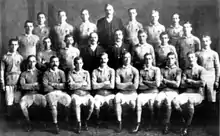
In 1908, largely through the switch of the popular and talented Dally Messenger to the paid football code of rugby league, that sport established itself into the culture of Sydney. Although Australian football remained popular, the NSWAFL was still denied access to enclosed grounds and the new professional code of rugby league further lured players from Australian rules. By 1911, Australian rules had achieved more support than rugby union, according to The Referee but only because support had shifted to rugby league.[18]
Postwar revival
The Australian National Football carnival of 1933 was held at the Sydney Cricket Ground. Several matches drew large crowds, particularly those involving New South Wales, Victoria, Queensland, South Australia and West Australia.
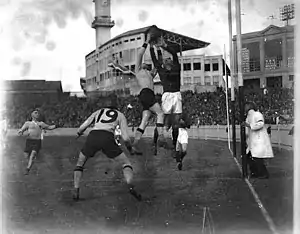
Following the successful interstate football carnival, in 1933 a proposal by the New South Wales Rugby League to amalgamate Australian football and rugby league was investigated and a report, with a set of proposed rules, known as Universal football, was prepared by the secretary of the NSWRL, Harold R. Miller and sent to the Australian National Football Council. A trial game was held in secret, but the plans were never instituted.
Three of the original NSWAFL clubs are still in existence and currently play in the Sydney AFL — North Shore, East Sydney (now UNSW-ES) and Balmain, but the league remained almost entirely amateur with limited audience following and sponsorship.
The "St. George and Sutherland Shire Junior Australian Football Association" was established in southern Sydney and consisted of Penshurst Junior Australian Football Club (JAFC) "Panthers", Miranda JAFC "Bombers", St. Patricks Ramsgate later Ramsgate JAFC "Rams", Heathcote JAFC "Hawks", Cronulla JAFC "Sharks" and, earlier, Peakhurst, Como-Jannali, Boys' Town, Cronulla "Blues" clubs and St. Patricks Sutherland.
Top level VFL returned to the SCG on 14 June 1952 when the Collingwood Football Club 10.12 (72) defeated Richmond Football Club 5.6 (36) in front of 24,174 spectators. However it wasn't to return for another few decades. During the late 1970s there was a surge of interest nationally. The VFL scheduled 2 premiership matches for the Sydney Cricket Ground in 1979. On 10 June 1979, North Melbourne Football Club 16.9 (105) defeated Hawthorn Football Club 23.18 (156) in front of a large crowd of 31,395. However a few months later just 17,140 attended a match in which Fitzroy 20.15 (135) defeated Richmond Football Club 22.20 (152). The small attendance didn't deter a financially struggling Fitzroy Lions from conducting a feasibility study into the possibility of moving to North Sydney and a proposal was put forward, but was voted down by its board in 1980.[19] The VFL scheduled 4 matches for the SCG in 1980. These matches were designed to test the market. The VFL's market studies found an increase in television ratings in Sydney and sustained attendance at matches. Based on the market study the VFL stated that there was sufficient support for a Sydney team, and that it intended to have one, possibly as soon as 1982.[20] A 1981 report by Graham Huggins concluded that there was an "untapped market in Sydney which represented an excellent opportunity for the league."[21] In 1981 the VFL had decided that it would establish an entirely new 13th VFL club in Sydney.[21] However this triggered South Melbourne to announce its move to Sydney.
The first professional VFL/AFL players from Sydney and the Sydney AFL did not begin to emerge until the 1980s. Russell Morris was one of the early players to make the grade, followed by Sanford Wheeler, Mark Roberts, Greg Stafford, Nick Davis and Lenny Hayes. In recent years, there has been a dramatic increase in AFL players coming from the Sydney region, and in 2007, a total of 11 AFL players identified themselves as coming from this region.[22]
Riverina
Australian Football was introduced to the Riverina region of New South Wales in Wagga Wagga in 1881 with a match between sides from the Wagga Wagga Football Club and Albury Football Club.[23] Subsequently, a local competition formed in 1884 around Wagga Wagga. The league went through many incarnations including the -
- Wagga Football Association (1888[24] - 1889)
- Wagga United Football Association (1890[25] - 1897).
- Murrumbidgee District Football Association (1897),
- Wagga United Football Association (1898 - 1921),
- Riverina Mainline Football Association (1922),
- Wagga United Football Association (1923,[26] 1924,[27] 1925[28])
- The Rock and District Association (1926 - 1927)[29] District towns based teams competition.[30]
- Wagga and District Association (1926 - 1927) Wagga based teams competition.[31][32]
- Wagga Football Association (1928–1957).
In 1905, the Wagga Football Association representative side lost a close match against the Fitzroy Football Club at Wagga.[33]
In these early days, the Ovens and Murray Football League produced champion players including Haydn Bunton, Sr., who was born and breed in Albury and played with the Albury Rovers FC, Albury Football Club and West Albury prior to playing with Fitzroy in the VFL in 1931.
The South Western District Football League commenced in 1894 and the Farrer Football League superseded the Albury & District Football League in 1957.
During the 1970s, the region produced many great footballers including the famous Daniher family, Terry Daniher, Neale Daniher, Anthony Daniher and Chris Daniher.
In 1982, at the instigation of the Victorian Country Football League (who had jurisdiction over the area at the time), the South Western District Football League, the Farrer Football League and the Central Riverina Football League were all combined into the Riverina Football League and the Riverina District Football League. The district league reverted to the Farrer Football League in 1985.
In 1995, these two leagues came under one umbrella of the Murrumbidgee Valley Australian Football Association.
Further south towards the Murray River, the Ovens & Murray Football League including teams from Albury formed as the Ovens & Murray Football Association in 1893.
Clubs also formed in the smaller towns around the mid to late 1890's and early 1900's and played ad hoc fixtures against each other, as well as organising formal competitions during the first half of the 1900's in Southern Riverina and Central Riverina, such as the -
- Federal District Football Association 1897 - 1902
- Deniliquin Football Association: 1900 - 1932
- McLaurin Football Competition: 1901
- Southern Riverina Football Association: 1905 - 1931
- Greengunyah Football Association: 1906
- Corowa & District Football Association: 1906 & 1907
- Central Riverina Football League: 1907[34]
- Lockhart Football Association: 1908 & 1909, 1911 - 1914, 1921, 1925.
- Coreen & District Football Association: 1909 - 1930
- The Rock Football Association: 1910 & 1911, 1914,
- Culcairn & District Football Association 1910 - 1913, 1919 - 1921
- Walbundrie Football Association: 1914
- Milbrulong Football Association: 1914 & 1915
- Walla Walla Football Association: 1915 & 16, 1919 - 1921
- Urangeline Football Association: 1919 - 1926
- Faithful & District Football Association: 1920 - 1939
- Borree Creek Football Association: 1922
- Hume Football Association: 1922 - 1926
- Lockhart Oaklands Line Football Association: 1923 & 1924
- Riverina Football Association: 1924 - 1929
- Osborne & District Football Association: 1927 & 1928
- Lockhart & District Lines Football Association: 1929
- Central Hume Football Association: 1929 - 1934
- Albury & District Football League: 1930 - 1957
- Corowa & District Football Association: 1931 - 1935
- Coreen & District Football League: 1936 - 2007
At the conclusion of the 2007 season the Coreen league was disbanded with most of its clubs joining the Hume league for the 2008 season.
In the modern era, the Riverina has produced a wealth of players for the VFL/AFL, including champion players including Wayne Carey, Paul Kelly, Dennis Carroll, John Longmire, Leo Barry, Shane Crawford and Brett Kirk. Some other players from the region to have played AFL level football include Isaac Smith (footballer), Luke Breust, Zac Williams, Dean Terlich and Sam Rowe.
Australian rules football is the most popular sport in Albury and equal in popularity with rugby league in Wagga Wagga, but is behind rugby league as the largest sport in Griffith.
Western New South Wales
Australian football was first played in Broken Hill in 1885 between Day Dream and Silverton. Informal competition began in 1888 between 4 clubs. The Barrier Ranges Football Association formed in 1890, which later became the Broken Hill Football League. In recent years, the area has produced such players as Dean Solomon, Brent Staker and Taylor Walker. Steve Hywood played on the Half Back Flank for Richmond in the 1972 VFL Grand Final losing to Carlton. Due to transfer problems he resumed his career at Glenelg in 1973 and played in the 1973 Glenelg Premiership team. Hywood was seen as one of the best Back Flankers ever to play the game.[35]
Newcastle
Australian football was introduced to Newcastle, New South Wales in 1883 when the Wallsend and Plattsburg Football Club was formed by miners from Ballarat.[36]
In 1888, the Black Diamond Cup, Australia's oldest existing and active sporting trophy, was first awarded to the champion team in the region.[36][37][38] In 1889 a donation of five guineas by Northern Districts Football Association (Australian Rules) patron[39] Mr. Stewart Keightley and a further donation of five guineas by the proprietors of the Newcastle Morning Herald led to the procurement of the Junior Challenge Cup.[40] This Cup was supplied by A. J. Potter (Alfred John Potter), watchmaker and jeweller of Hunter Street Newcastle.[41]
Five clubs were established in the Newcastle area: Newcastle City, Wallsend and Plattsburg, Northumberland, Lambton, and Singleton.
In 1883, a touring South Melbourne Football Club defeated a combined Northern District team by only one goal.
In 1888, a touring c defeated Wallsend by 10 goals to 5. The following year, Wallsend defeated Fitzroy.
Isaac Heeney was drafted by the Sydney Swans in 2014 making him the first Newcastle-born footballer to play in the AFL.
South Coast
The game was first played at a senior level in 1969. There are eight teams that compete in the AFLSC senior's competition and eleventeams in the reserves. In terms of junior numbers there has been a significant expansion since 1999. AFL players to have come from the South Coast include Arthur Chilcott, Aidan Riley and Ed Barlow.[42]
North Coast
The game was first played in the Coffs Harbour area as late as 1978. The North Coast Australian Football League was formed in 1982 and grew rapidly with up to 8 clubs by 2000. In recent years the number of clubs has declined due to Woolgoolga, Nambucca, Kempsey and Urunga folding. North Coffs and South Coffs were forced to merge before the start of the 2015 season due to lack of player numbers. The area has produced AFL players including Sam Gilbert.
Sydney Swans
The debt ridden South Melbourne Football Club's team was moved to Sydney in 1982 and was renamed the Sydney Swans. It became the first team based outside of Victoria and represented the VFL's first serious attempt to broaden its competition, culminating in its extension into a national competition and renaming to the Australian Football League. One of the unfortunate consequences of the relocation of Swans from South Melbourne to Sydney was the attraction of support, including sponsorship away from the local Australian rules football clubs and leagues and there was an initial decline in the sport locally. The Swans' debt, much of it to the AFL not only hung over attempts to establish the Sydney Swans but now burdened Australian rules football in New South Wales.
On 31 July 1985, Dr Geoffrey Edelsten, through Powerplay Limited, bought the Sydney Swans for $2.9 million in cash with debt payments, funding and other payments spread over five years (rumoured to be a total of $6.3 million). Powerplay was floated and sold shares to supports and the public but with only a licence to the team and debts the uptake was poor. Within less than twelve months, Edelsten resigned as chairman and by 1988 the licence was sold back to the VFL for just $10. Losses were in the millions. The AFL appointed a board to operate the team. Board members Mike Willesee and Craig Kimberley together with Basil Sellers, Peter Weinert as a consortium known as the Private Ownership Group purchased the licence and operated the Sydney Swans until 1993, when the AFL again took over ownership of the team.
With substantial monetary and management support from the AFL, the Sydney Swans continued and with player draft concessions in the early 1990s, has fielded a competitive team throughout the decade. In 1996 the Swans lost the grand final to North Melbourne, which had been their first appearance in a grand final since 1945. The game was played in front of 93,102 at the MCG. Since 1995, the Swans have only missed the finals five times, including in the COVID-affected 2020 season in which they played only four home games and finished third-last on the ladder.
The culmination of the recent success was the 2005 premiership against the West Coast Eagles played in front of 91,898 at the MCG, taking the flag to Sydney for the first time and breaking a 72-year drought for the club from when it was based in South Melbourne. It also broke the longest premiership drought in the history of the competition.[43] Another flag followed not long after, in 2012.[44]
The AFL had eventually established the Swans in Sydney but the model of off-loading a debt-laden team to a new market had resulted in enormous cost to the AFL passed on to its other member clubs and ultimately supporters. Despite the eventual success of the Swans, the former Melbourne based club had struggled for many years to gain support of the Sydney public and the AFL and Australian rules football are still behind rugby league in the Sydney market.
Greater Western Sydney Giants
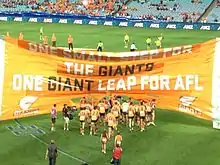
The Australian Football League expressed intentions to invest in junior development in the growing Sydney market, particularly in Sydney's west and compete head on with the established rugby football codes.
A second team in Sydney became a key strategy of the AFL. North Melbourne Football Club, which was suggested as a likely candidate for relocation, played several home games in Sydney in 1998 but poor crowds led to the Kangaroos abandoning this. The Western Bulldogs have been also suggested as a candidate for relocation.
In 2005, the AFL went on a Sydney-centric recruitment drive, offering a NSW scholarships program and young apprentice scheme.[45] By 2007, at least two of the NSW and ACT scholarship recipients had been officially promoted to AFL rookie lists, qualifying them for selection in the senior squad in the event of long-term injury to listed players.
In 2008, the AFL stated their intention to establish a second team in Sydney to be based in the western suburbs, as part of the expansion of the competition. This process was completed with the establishment of the Greater Western Sydney Giants who played for a season in the North East Australian Football League prior to commencing competition in the Australian Football League in 2012. The Giants struggled in their early years, winning only three games in their first two seasons, but since then made gradual progress up the ladder, culminating in a Grand Final appearance in 2019.[46] Although the Giants have been somewhat successful, the club has done little to influence the strength of rugby league in the Western Sydney area.
AFL NSW/ACT Commission Limited
The AFL established the AFL NSW/ACT Commission Limited to govern its expansion in NSW and the ACT.
Participation
Ausplay reported that there were 69,168 regular participants in Australian rules in New South Wales in 2019.[2]
7,225 (adult) While lower than the AFL reported figure for 2011 of 131,829 (which included the ACT and 41,626 Auskick registrations) the state has now eclipsed rugby union participation in New South Wales.[47]
In 2012, the figure was 148,230 people of which 48,965 were Auskick registrations.[48] In 2013, the number of Australian football participants in NSW and the ACT had jumped up to 177,949 of which 47,888 were Auskick participants. According to the AFL Football Record this means that the only state that has more Australian football players is Victoria.
The Australian Bureau of Statistics "Children's Participation in Cultural and Leisure Activities, Australia, Apr 2009" estimated 18,000 Australian rules football participants in NSW and 1,400 in the ACT.[49](table 22) The ABS utilised a small sample size of 20,126 private dwelling in obtaining their data of participation numbers for 2011/12.[50]
In 2007, there were 7,225 senior players in NSW and the ACT and in 2006 a total of around 95,100 participants.[51] Although Australian rules football was one of the fastest growing sports in the state, the overall participation per capita was only about 1%, the lowest in Australia. .
Audiences
Attendance Record
- 72,393 (2003). AFL Sydney Swans v. Collingwood Football Club at Stadium Australia, Sydney.
Attendances
In 2006, the Sydney Swans averaged 41,205 people through the gate per home match. In 2013, the average had decreased to 29,104 with the suggestion that this was partly due to the redevelopment of the Bradman Stand at the SCG.[52]
Major Australian rules football events in New South Wales
- Australian Football League premiership season (Sydney Swans and Greater Western Sydney Giants)
- Australian Football League NSW Derby – Swans v Giants (held twice annually at ANZ Stadium starting in 2012)
- Annual Exhibition Match (North Sydney Oval) Sydney Swans vs Essendon
Notable players
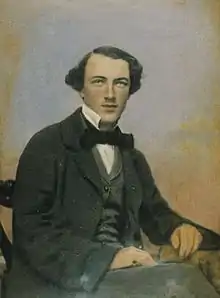
A number of notable players have been born in New South Wales or played the majority of their junior careers in New South Wales; many of these players have been from the traditional Australian rules football areas of Broken Hill or the Riverina. Australian football pioneers Tom Wills and H. C. A. Harrison were born in New South Wales in the 1830s.
Notable players from the Riverina include: Australian Football Hall of Fame Legend Haydn Bunton, Sr. (Albury), who was the first player born in New South Wales to win the Brownlow Medal and the Sandover Medal, in 1931 and 1938 respectively; Paul Kelly from Wagga the first New South Welshman to win the Brownlow, Shane Crawford (Finley) who won the Brownlow in 1999; and Wayne Carey (Wagga), won the Leigh Matthews Trophy twice in the 1990s. Notable players from Broken Hill include Dave Low, Robert Barnes and Bruce McGregor, who all won Magarey Medals in the 1910s and 1920s, and Jack Owens, a three-time South Australian National Football League (SANFL) leading goalkicker.
Many notable players have also been recruited from Sydney, as the game has had a long history, having been played in the city since 1880. This pre-dates many other major sports.[53] Despite the lack of media attention the game has received, Sydney has still generated many players of high quality. Some of the best include Roger Duffy (1954 premiership player who was recruited from Newtown), Michael Byrne (1983 premiership player with Hawthorn who was recruited from the Sydney club of North Shore), Bob Merrick (a leading goal kicker in the 1920s recruited from East Sydney), Mark Roberts a 202-game AFL player from 1985 to 1999 who played junior football for Ramsgate AFC and senior football for St. George AFC before playing in the AFL for the Sydney Swans, Brisbane Bears and North Melbourne, notably in their 1996 premiership, Greg Stafford (a 200-game player recruited from Western Suburbs in Sydney), Jarrad McVeigh (2012 AFL premiership captain) and his brother Mark (who played for Essendon), Lewis Roberts-Thomson (2005 & 2012 premiership player for the Swans) and Lenny Hayes (2010 Norm Smith Medallist) amongst others.[54]
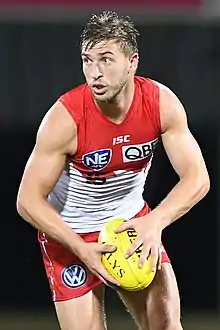 Keiren Jack, former Sydney Swans captain is from Sydney
Keiren Jack, former Sydney Swans captain is from Sydney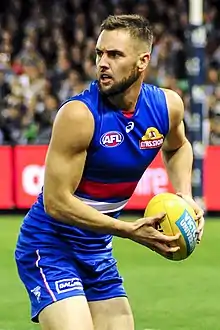 Matt Suckling, premiership player, is from Wagga
Matt Suckling, premiership player, is from Wagga_(cropped).jpg.webp) Jarrad McVeigh Sydney Swans premiership player is from Sydney
Jarrad McVeigh Sydney Swans premiership player is from Sydney.jpg.webp) Cameron Mooney 3 time premiership player is from Wagga
Cameron Mooney 3 time premiership player is from Wagga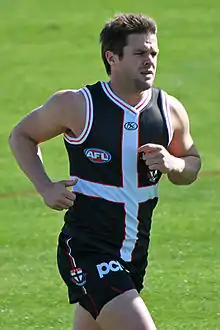 Adam Schneider Sydney premiership player is from Osborne
Adam Schneider Sydney premiership player is from Osborne Brett Kirk, Sydney Swans premiership player and coach is from Albury
Brett Kirk, Sydney Swans premiership player and coach is from Albury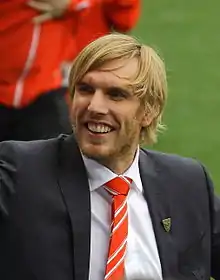 Lewis Roberts-Thompson Sydney Swans premiership player is from Sydney
Lewis Roberts-Thompson Sydney Swans premiership player is from Sydney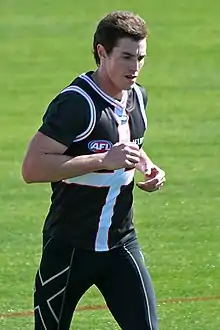 Lenny Hayes AFL Hall of Famer is from Sydney
Lenny Hayes AFL Hall of Famer is from Sydney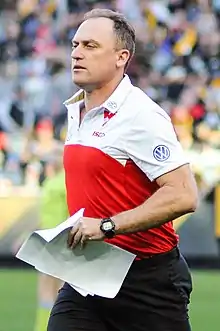 John Longmire premiership player and coach is from Corowa
John Longmire premiership player and coach is from Corowa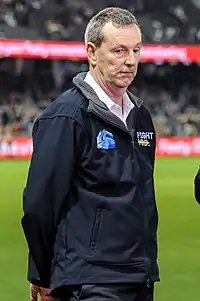 Neale Daniher is from West Wyalong
Neale Daniher is from West Wyalong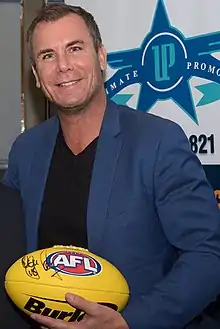 Wayne Carey North Melbourne premiership captain is from Wagga
Wayne Carey North Melbourne premiership captain is from Wagga_(7176553482).jpg.webp) Statue of Paul Kelly, Brownlow Medallist Sydney Swans captain and rugby league convert was from Wagga
Statue of Paul Kelly, Brownlow Medallist Sydney Swans captain and rugby league convert was from Wagga Bruce McGregor was from Broken Hill
Bruce McGregor was from Broken Hill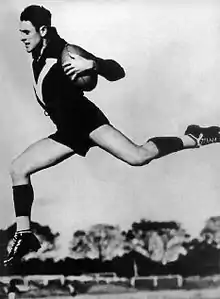 Haydn Bunton Sr. was from Albury
Haydn Bunton Sr. was from Albury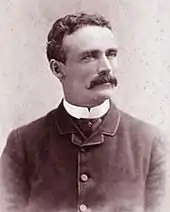 H. C. A. Harrison one of the fathers of Australian Rules Football was from Picton
H. C. A. Harrison one of the fathers of Australian Rules Football was from Picton
Current Players
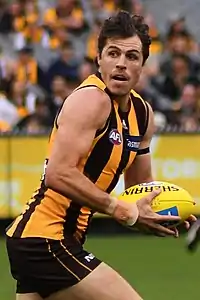 Isaac Smith, Hawthorn premiership player is from Cootamundra
Isaac Smith, Hawthorn premiership player is from Cootamundra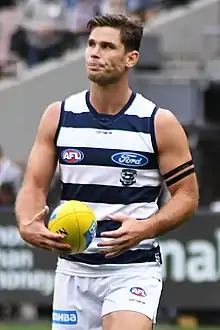 Tom Hawkins, premiership player with Geelong is from Finley
Tom Hawkins, premiership player with Geelong is from Finley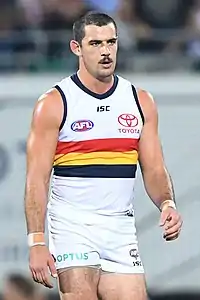 Taylor Walker, former Adelaide captain is from Broken Hill
Taylor Walker, former Adelaide captain is from Broken Hill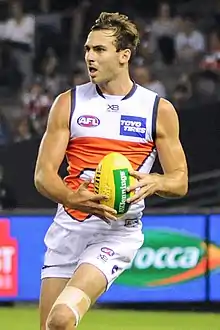 Jeremy Finlayson is from Culcairn
Jeremy Finlayson is from Culcairn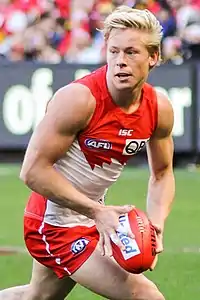 Isaac Heeney is from Maitland
Isaac Heeney is from Maitland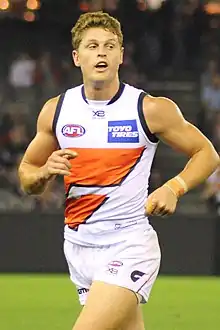 Jacob Hopper is from Leeton
Jacob Hopper is from Leeton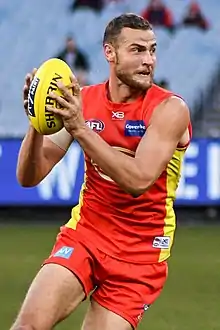 Jarrod Witts is from Sydney
Jarrod Witts is from Sydney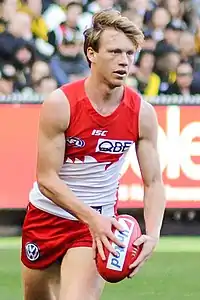 Callum Mills is from Northern Beaches in Sydney
Callum Mills is from Northern Beaches in Sydney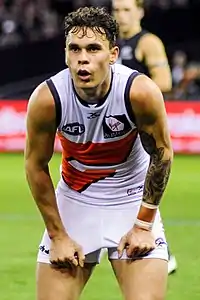 Zac Williams is from Narrandera
Zac Williams is from Narrandera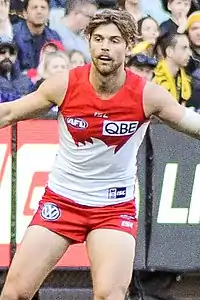 Dane Rampe is from Clovelly in Sydney
Dane Rampe is from Clovelly in Sydney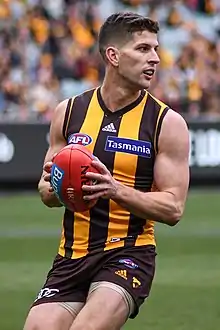 Luke Breust, Hawthorn premiership player is from Temora
Luke Breust, Hawthorn premiership player is from Temora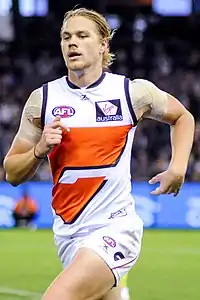 Harrison Himmelberg is from Wagga
Harrison Himmelberg is from Wagga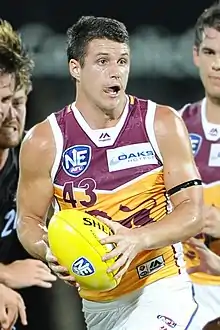 Jake Barrett is from Temora
Jake Barrett is from Temora
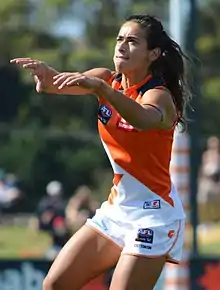 Amanda Farrugia was recruited from Sydney
Amanda Farrugia was recruited from Sydney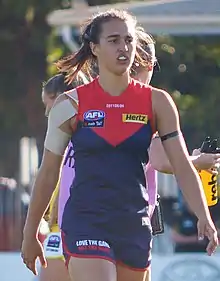 Brenna Tarrant was recruited from Sydney
Brenna Tarrant was recruited from Sydney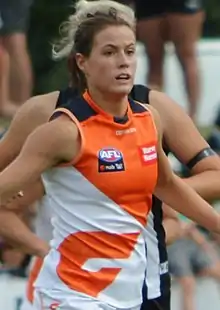 Nicola Barr was schooled in Sydney
Nicola Barr was schooled in Sydney Ashleigh Brazill is from Campbelltown
Ashleigh Brazill is from Campbelltown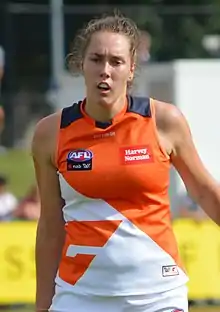 Erin McKinnon All Australian was recruited from Sydney
Erin McKinnon All Australian was recruited from Sydney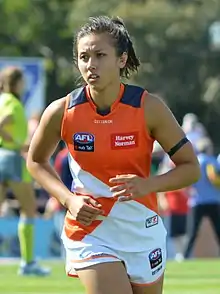 Rebecca Beeson was recruited from Sydney
Rebecca Beeson was recruited from Sydney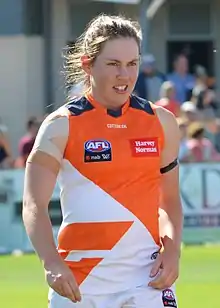 Jodie Hicks is from Hay
Jodie Hicks is from Hay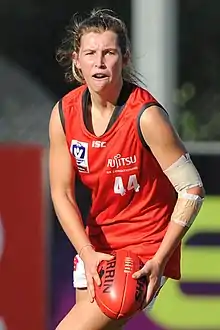 Maddy Collier was recruited from Sydney
Maddy Collier was recruited from Sydney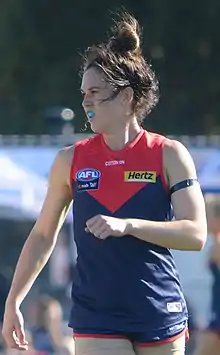 Gabrielle Colvin is from Wagga
Gabrielle Colvin is from Wagga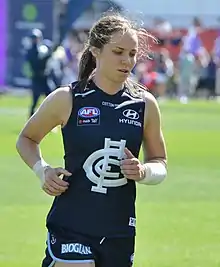 Chloe Dalton is from Sydney
Chloe Dalton is from Sydney
Representative Team
The New South Wales representative team, nicknamed the Blues, played Interstate matches against other Australian states and Territories. The team wore a blue uniform with a Waratah symbol badge and until the 1970s was the only representative team to buck the trend of sleeveless guernseys (in effort to fit with the fashions in rugby). The highlight for the Blues came in 1990 when they defeated the traditional powerhouse state of Victoria by 10 points at the Sydney Cricket Ground. The team later merged with the Australian Capital Territory team, to form the NSW/ACT Rams. Notable players to represent NSW/ACT include Brownlow Medalists Shane Crawford and James Hird, as well as Wayne Carey. The team later combined with Northern Territory, Queensland and Tasmania to form Allies. Interstate football ceased in 1999 and has not since returned at senior level, apart from a one off hall of fame tribute match in 2008, to celebrate the 150 anniversary of the sport, and a one off Bushfire Relief Match in 2020 to raise money for victims of the 2019-20 bushfires.
New South Wales and the Australian Capital Territory are represented at the under 18 level and in the TAC Cup.
Principal venues
| Sydney | Sydney | Sydney |
|---|---|---|
| Stadium Australia | Sydney Cricket Ground | Sydney Showground Stadium |
| Capacity: 82,500 | Capacity: 48,000 | Capacity: 25,500 |
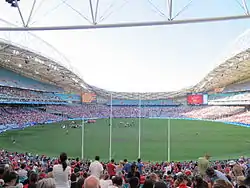 |
.jpg.webp) |
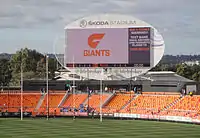 |
Sydney
- Sydney Cricket Ground
- Stadium Australia, Sydney Olympic Park.
- Sydney Showground Stadium, Sydney Olympic Park.
- North Sydney Oval
- Blacktown ISP Oval, Rooty Hill.
- Bruce Purser Reserve, Kellyville.
- Ern Holmes Oval, Pennant Hills.
- Henson Park, Marrickville.
- Picken Oval, Croydon Park
- Trumper Park Oval, Paddington.
- Monarch Oval, Macquarie Fields.
- Village Green, University of New South Wales, Kensington.
- Drummoyne Oval
- Gore Hill Oval
- Olds Park, Penshurst.
- University Oval, University of Sydney.
- Jubilee Oval, Carlton.
Regional NSW
- Lavington Sports Ground, Hamilton Valley, Albury.
- Newcastle Number 1 Sports Ground, Newcastle
- Coffs Harbour International Stadium, Coffs Harbour
- Narrandera Sports Ground, Narrandera
- North Dalton Park, Towradgi, Wollongong.
- Robertson Oval, Wagga Wagga
References
- "Football in Sydney". The Australasian. Vol. I, no. 10. Victoria, Australia. 9 June 1866. p. 11. Retrieved 29 April 2022 – via National Library of Australia.
- Ausplay Australian Football report 2019
- Is Sydney finally an AFL town?
- Rugari, Vince (17 April 2021). "Australian rules football is booming in Sydney. Is it happening at rugby’s expense?", The Age. Retrieved 3 April 2022.
- "Advertising". The Sydney Morning Herald. Vol. LII, , no. 8501. New South Wales, Australia. 19 August 1865. p. 4. Retrieved 1 May 2022 – via National Library of Australia.
{{cite news}}: CS1 maint: extra punctuation (link) - "NOTES OF THE WEEK". The Sydney Morning Herald. Vol. LII, no. 8507. New South Wales, Australia. 26 August 1865. p. 8. Retrieved 29 April 2022 – via National Library of Australia.
- Bell's Life in Sydney. 18 July, 1867
- Bell's Life in Sydney. 3rd August, 1867
- "FROM THE 3RD JULY TO THE 10TH JULY". The Sydney Morning Herald. Vol. LVIII, , no. 9408. New South Wales, Australia. 15 July 1868. p. 5. Retrieved 1 May 2022 – via National Library of Australia.
{{cite news}}: CS1 maint: extra punctuation (link) - "TOWN AND COUNTRY". Sydney Mail. Vol. IX, no. 419. New South Wales, Australia. 11 July 1868. p. 5. Retrieved 29 April 2022 – via National Library of Australia.
- "INTERCOLONIAL FOOTBALL MATCH". The Argus (Melbourne). No. 9, 680. Victoria, Australia. 25 June 1877. p. 6. Retrieved 25 November 2021 – via National Library of Australia.
- New South Wales vs New Zealand from NSW Australian Football History Society
- M. P. Sharp, Football in Sydney before 1914 Archived 3 July 2008 at the Wayback Machine, Sporting Traditions Vol 4 No 1 November 1987.
- "FOOTBALL IN SYDNEY". The Argus (Melbourne). No. 17, 742. Victoria, Australia. 25 May 1903. p. 6. Retrieved 24 November 2021 – via National Library of Australia.
- "FOOTBALL GOSSIP". Leader. No. 2483. Victoria, Australia. 8 August 1903. p. 17. Retrieved 7 October 2021 – via National Library of Australia.
- "MATCH IN SYDNEY". The Argus (Melbourne). No. 18, 057. Victoria, Australia. 30 May 1904. p. 9. Retrieved 24 November 2021 – via National Library of Australia.
- "AUSTRALIAN FOOTBALL". The Australian Star. No. 5417. New South Wales, Australia. 24 June 1905. p. 8 (FIRST EDITION). Retrieved 7 October 2021 – via National Library of Australia.
- S. Fagan, 'Rules' Almost Had Sydney's Paddock Archived 17 May 2008 at the Wayback Machine in rl1908.com, 2006.
- Jim Main, Shake Down The Thunder, Geoff Slattery Publishing, 2006, ISBN 0-9757964-6-1
- "SYDNEY-BASED TEAM ULTIMATE AIM OF V.F.L." The Canberra Times. Vol. 54, no. 16, 278. Australian Capital Territory, Australia. 20 April 1980. p. 26. Retrieved 24 November 2021 – via National Library of Australia.
- https://trove.nla.gov.au/newspaper/article/125641831
- Hot Spots – Breeding Grounds of Today's AFL Footballers Archived 2 November 2012 at the Wayback Machine from theage.com.au
- "1881 - Football". Wagga Wagga Advertiser (NSW). 2 August 1881. p. 2. Retrieved 23 February 2022.
- "1888 - Wagga Football Association". Wagga Wagga Advertiser (NSW). 2 October 1888. p. 2. Retrieved 23 February 2022.
- "1890 - Wagga United Football Association". Wagga Wagga Advertiser (NSW). 1 May 1890. p. 2. Retrieved 23 February 2022.
- "1923 - Football - Australian Rules". Daily Advertiser (Wagga Wagga, NSW). 14 May 1923. p. 2. Retrieved 22 February 2022.
- "1924 - Football". Daily Advertiser (Wagga Wagga, NSW). 21 April 1924. p. 4. Retrieved 22 February 2022.
- "1925 - Mangoplah wins PA Cup". Daily Advertiser (Wagga Wagga, NSW). 9 September 1925. p. 6. Retrieved 23 February 2022.
- "1926 - Australian Rules Football Crisis". Daily Advertiser (Wagga Wagga, NSW). 10 April 1926. p. 4. Retrieved 23 February 2022.
- "1926 - The Rock Cup Final". Daily Advertiser (Wagga Wagga, NSW. 16 September 1926. p. 4. Retrieved 23 February 2022.
- "1926 - Newtown Premiers". Daily Advertiser (Wagga Wagga, NSW). 6 September 1926. p. 3. Retrieved 23 February 2022.
- "1927 - Rovers defest Currawarna". Daily Advertiser (Wagga Wagga, NSW). 12 September 1927. p. 4. Retrieved 23 February 2022.
- "1905 - Fitzroy v Wagga". Wagga Wagga Express (NSW). 22 June 1905. p. 3. Retrieved 23 February 2022.
- "1907 - Central Riverina Football League". Narandera Argus and Riverina Advertiser (NSW). 31 May 1907. p. 2. Retrieved 25 February 2022.
- A BRIEF HISTORY OF FOOTBALL IN BROKEN HILL (archived, 2 May 2006)
- "Football gold mined in coal country". Australian Football 150 Years. Australian Football League. Archived from the original on 6 July 2011. Retrieved 18 March 2010.
- "History of football in this league". Black Diamond AFL. Retrieved 18 March 2010.
- "Black Diamond Football League Kicking Goals in Grassroots Administration". SportingPulse. 30 September 2002. Retrieved 18 March 2010.
- "LOCAL NEWS". The Maitland Mercury and Hunter River General Advertiser. Vol. XLVI, no. 6394. New South Wales, Australia. 18 April 1889. p. 5. Retrieved 14 July 2021 – via National Library of Australia.
- "NORTHERN FOOTBALL ASSOCIATION". Newcastle Morning Herald and Miners' Advocate. Vol. XVI, no. 11, 064. New South Wales, Australia. 17 April 1889. p. 3. Retrieved 14 July 2021 – via National Library of Australia.
- "A FOOTBALL TROPHY". Newcastle Morning Herald and Miners' Advocate. Vol. XVI, no. 11, 106. New South Wales, Australia. 7 June 1889. p. 8. Retrieved 14 July 2021 – via National Library of Australia.
- Wilks, M. (2011) Australian football clubs in NSW Bas Publishing. p. 141
- "Finals Flashback: 2005 AFL Grand Final". ABC News (Australian Broadcasting Corporation). 26 September 2014. Retrieved 11 July 2020.
- "Swans snatch victory in classic grand final". ABC News (Australian Broadcasting Corporation). 1 October 2012. Retrieved 11 July 2020.
- AFL courts Sydney market Archived 4 March 2016 at the Wayback Machine ABC Radio transcript
- McGowan, Marc. "Gargantuan: Depleted Giants shock Pies to reach first Grand Final". AFL.com.au. Archived from the original on 15 September 2019. Retrieved 24 September 2019.
- Ed. Michael Lovett (2013) AFL Record Season Guide 2013. Slattery Media Group. p 1066
- Ed. Michael Lovett (2012) AFL Record Season Guide 2012 & 2013. Slattery Media Group. p 1008 & 1034
- "Archived copy". Archived from the original on 22 May 2016. Retrieved 2010-12-19.
{{cite web}}: CS1 maint: archived copy as title (link) - "Archived copy". Archived from the original on 4 March 2016. Retrieved 2013-11-02.
{{cite web}}: CS1 maint: archived copy as title (link) - More chase Sherrin than before – realfooty.com.au Archived 4 February 2009 at the Wayback Machine
- "Sydney Swans Crowds and Match Attendances". Archived from the original on 4 March 2016. Retrieved 2013-10-28.
- "CHRONOLOGICAL HISTORY OF NSW FOOTBALL – NSW Australian Football History Society Inc". Archived from the original on 29 July 2016. Retrieved 2014-01-25.
- Wilks, M. (2011) Australian football clubs in NSW Bas Publishing. ISBN 9781921496134 p. 61 & 75
External links
- The Hidden Story of Australian Rules in Sydney
- NSW Footy History
- Australian Rules Almost Held Sydney
- "NSW Team of the Century". Full Points Footy. Archived from the original on 9 January 2012.
- Sydney Australian Football Foundation – non-profit organisation assisting development of the code in Sydney